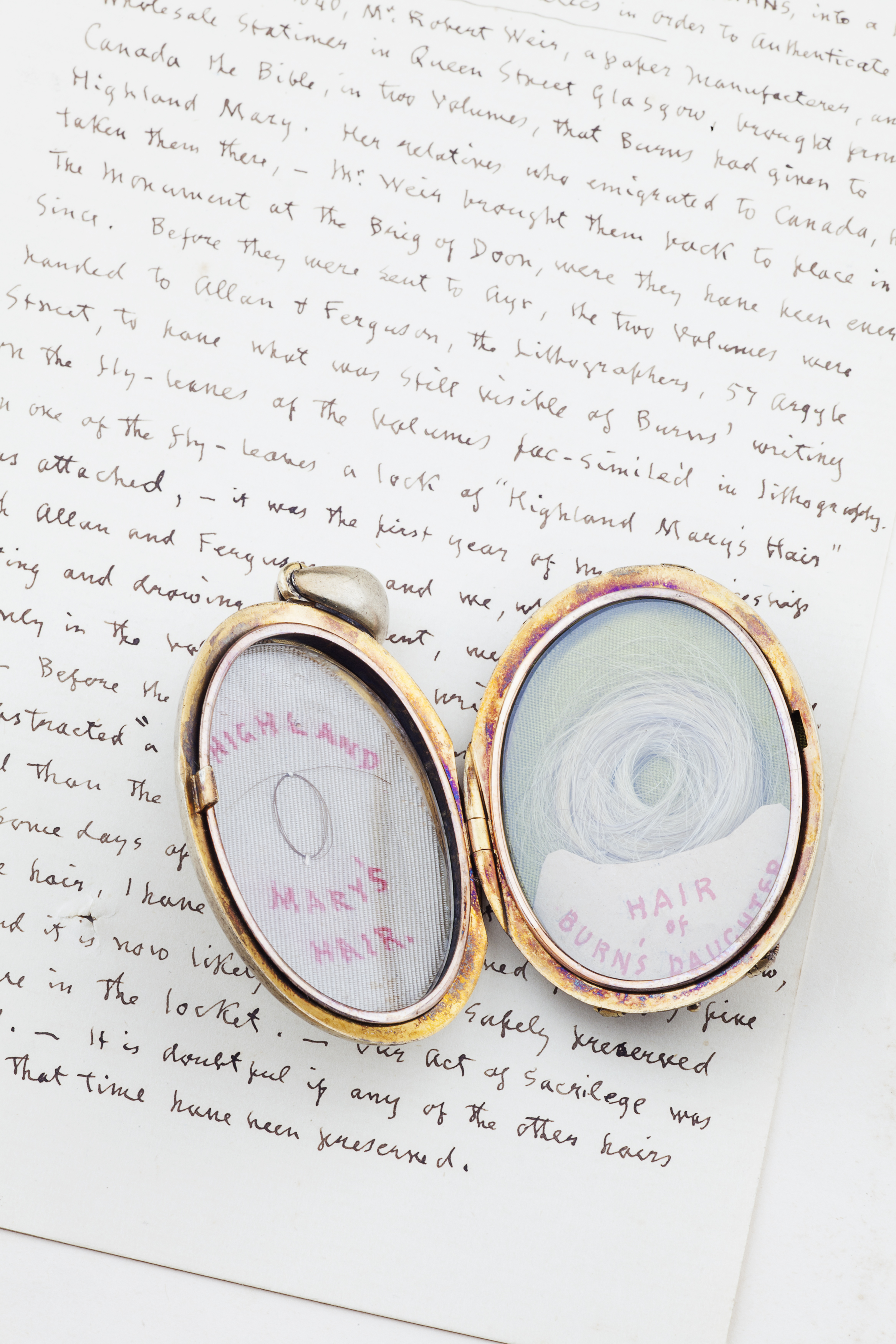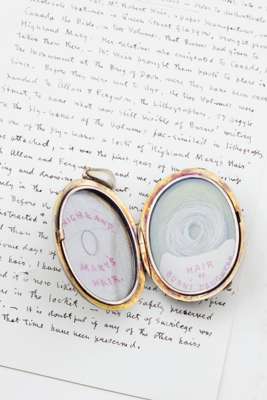
Lot 212

Robert Burns - a Victorian gold and pearl set locket


Auction: 13 August 2014 at 14:00 BST
Description
unmarked, the oval locket with thee pearls in box setting with scroll border, the hinged cover opening to reveal two locks of hair one inscribed to silk 'Highland Mary's hair' the other inscribed to paper label 'Hair of Burn's Daughter'
Dimensions
locket 6cm long (including suspension loop)
Footnote
Provenance:
Collected and preserved by William Simpson
then by direct descent
Notes:
These intriguing locks of hair have both been collected by William Simpson who in 1840, aged 17, was an apprentice at Allan & Ferguson printers and lithographers in Glasgow. Through his work he came into contact with the recently returned Burns / Campbell betrothal bible which had been returned from a relative of Mary Campbell in Canada who had inherited the bible given by Robert Burns in 1786 in the traditional for of marriage of the period. The lock of hair was pinned to the inner pages of the bible with hand written annotations from Burns, the lock contain within this locket was kept by William Simpson as a souvenir.
Mary Campbell or Highland Mary as she was regularly referred to fitted into a period of Burn's life when his beloved Jean Armour (later to become his wife) was being forced by her family not to follow her heart and marry Robert. In this short period Robert's reputation as a ladies' man was, perhaps, prevalent and did not help his circumstance.
Burns dedicated his poems The Highland Lassie O, Highland Mary and To Mary in Heaven to Mary. It has long been debated whether the lines "Will ye go to the Indies. my Mary, And leave auld Scotia's shore?" suggests that they planned to go to Jamaica together.
Highland Mary was to die suddenly in October 1786 for what has still been a much debated cause, excavations of her grave in 1920 suggest that she was pregnant at the time of her death (presumably with Robert's child) and theories of her contracting typhus from nursing her brother.
The second lock of hair comes from Elizabeth Thomson, who was an illegitimate child of Robert and Anna Park. Much has been written and said about Robert's many indiscretions and reputation but in the instance of Elizabeth it should noted she was adopted and raised by Jean Armour, Burn's long standing lover and wife.
William Simpson met with Elizabeth (known as Betty) Thomson in Shawlands, Glasgow where she was married to John Thomson a solider and later weaver. They had eight children and she lived their till her death 1873. William Simpson on meeting her presented her with a painting in oils titled 'Burns and Death', an accomplished war artist his reputation was cemented in Britain after his work in the Crimean Wars of the 1850's, and she in turn cut this lock from her hair.
sold with the following account of this history of these pieces in William Simpsons own hand;
19 Church Road. Willesden. N.W. 13. Oct. 1895.
Memorandum
Having today placed A HAIR of "HIGHLAND MARY" and a lock of HAIR of Mrs. THOMSON, A DAUGHTER of BURNS, into a locket, I write out this account of these relics in order to authenticate them.
________________________________
In December 1840, Mr. Robert Weir, a paper manufacturer, and Wholesale Stationer in Queen Street, Glasgow, brought from Canada the Bible, in two Volumes, that Burns had given to Highland Mary. Her relatives who emigrated to Canada, had taken them there, - Mr. Weir brought them back to place in the Monument at the Brig of Doon, were (sic) they have been ever since. Before they were sent to Ayr, the two volumes were handed to Allan & Ferguson, the Lithographers, 57 Argyle Street, to have what was still visible of Burns' writing on the fly-leaves of the volumes fac-similed in lithography. On one of the fly-leaves a lock of "Highland Mary's Hair" was attached, - it was the first year of my apprenticeship with Allan & Ferguson, - and we, who belonged to the writing and drawing department, were all much interested. Not only in the volumes and the writing, but also in the hair, - Before the volumes were returned to Mr. Weir, we had each "abstracted" a hair, - one of the young hands, less interested than the others perhaps, - gave me a piece of his hair some days afterwards, - but that I have lost somehow, but the one hair, I have carefully preserved for fifty-five years, - and it is now likely to be more safely preserved for the future in the locket. - Our act of sacrilege was never noticed. - It is doubtful if any of the other hairs abstracted at that time have been preserved.
I forget now what year it was when I saw Mrs. Thomson. It may have been perhaps in the sixties. Mrs. Thomson lived at the "Shaws" near Glasgow, and Hugh MacDonald took me to see her one day. I had painted a picture in oil of "Burns and Death", as an illustration of "Death and Dr. Hornbrook" , I forget know whether I took this to her as a present, or sent it afterwards, - She cut off a lock of her hair, and gave it to me. - which has been today, 13th. Oct. 1895, placed in the locket with the hair of "Highland Mary". Mrs. Thomson was an illigetimate (sic) daughter of Robert Burns, - she was brought up in the family with the other children, and she spoke highly of Mrs. Burns, "Jean Armour", - Her husband was a Cotton-spinner, so she lived in a humble enough sphere of life. She had a grown up daughter, who could sing very well, and Barnum tried, at the Anniversary of Burns' Birthday, to engage her to go to America and sing the Songs of Burns, - but she refused. Mrs. Thomson had wonderful eyes, - they were large, but not projecting, - If I recollect right they were of a deep brown, and may have been like her Father's, which have been spoken of as something that attracted attention. There are portraits of her and her daughter in my book of Portraits. Mrs. Thomson died in 1873. I forget now how many children she had, but I remember there was one son, and he was present at the Celebration of the Burns Anniversary in the Candleriggs, Glasgow, where Hugh MacDonald presided, and Alexn. Smith, was also present, and I formed one of the company.
William Simpson
~

